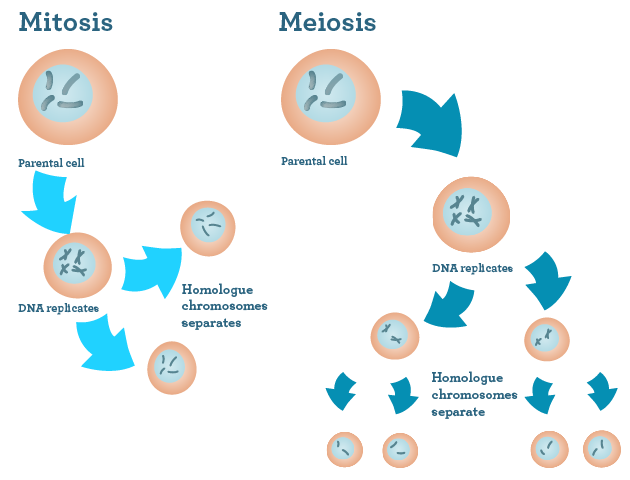Mitosis and Meiosis:
Mitosis is the process of replicating a cell and splitting in into two. Before it starts this process it must meet the certain requirements to stat. The first is to replicate its DNA, secondly is to gather enough nutrients, and lastly to make sure the DNA is not damaged. Then there are four stages of mitosis. Prophase, Metaphase, Anaphase, and Telophase. First is Prophase: The nuclear membrane disappears then spindle fibers appear along with chromosomes forming X shapes. Metaphase: Spindle fibers attach to chromosomes and align them in the middle or equator of the cell. Anaphase: The spindle fibers retreat to opposite poles of the cell pulling apart the chromosomes into two identical chromosomes. Telophase: Nuclear membrane forms around both new set of chromosomes and spindle fibers disappear. Cytokinesis: Finally cell splits into a identical daughter cell.
Source: http://www.bigstockphoto.com/image-78348347/stock-vector-6-stages-of-mitosis
Meiosis is process of cell division. Instead of one parent this needs two. Meiosis is also the production of gametes. Which are egg and sperm cells. Each cell has 23 chromosomes, a full chromosomes is 46, so half from the mother and the other half from the father. An example for sexual reproduction is internal fertilization is when a mans sperm reaches the women’s egg and starts the growth of a baby. The steps of meiosis is almost the same as mitosis but a bit longer. The first step is prophase I: X chromosomes form and spindle fibers form as well. Metaphase I: Chromosomes attach to one another (two x chromosomes.) and spindle fibers attach to them and align them in the middle. Anaphase I: The spindle fibers retreat to opposite poles and pulling apart the chromosomes apart into two identical X chromosomes. Telophase I: nuclear membrane appear around new set of chromosomes. Interkenesis. Cell separates into two daughter cells. Prophase II: Now there is two identical cells with their nuclear membrane disappears and spindle fibers form. Metaphase II: Spindle fibers attach to chromosomes and place them along the equator of the cell. Anaphase II: Spindle fibers go to opposite poles splitting the chromosomes into chromatids. Telophase II: Nuclear membrane forms around new chromatids and spindle fibers disappear. Cytokinesis: Both cell splits and there are now four new cells.
Source: https://www.howtosmile.org/topics/life-sciences
The difference between Meiosis and Mitosis:
In Mitosis there is only one parent, and in that matter there is no need to waste energy finding a mate. Also meiosis has two separation periods separating into 4 when mitosis only splits once into two daughter cells. Another difference is that in meiosis the homologues chromosomes separate not making them identical cells. Making the daughter cell not identical but mitosis makes two identical cells.
How organisms grow:
All multi cellular organisms grow because of cell division. Cell division is making new cells all the time. Cell division is making one cell into two, with the help of mitosis. Like skin cells, they divide to develop the structure. This applies to any cell in a multi cellular organism. Each cell goes through the phase or dividing and they start with interphase. This phase is the longest out of the three steps, the cell must replicate its DNA, gather nutrients, and make sure its DNA is not damaged. Then mitosis go through the four stages of it, prophase, metaphase, anaphase, telophase. After that is finished the third step is the actual dividing of the cell, cytokinesis.
Source: http://helpytips.com/unbelievable-facts/body-functions-work-even-death/

